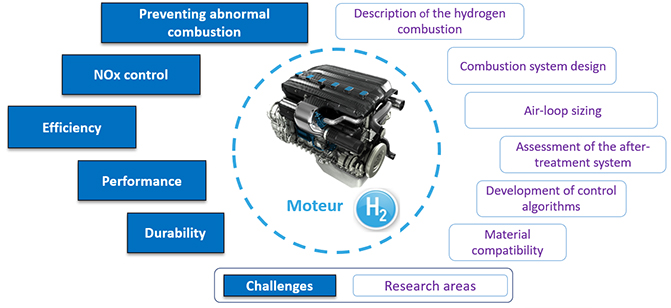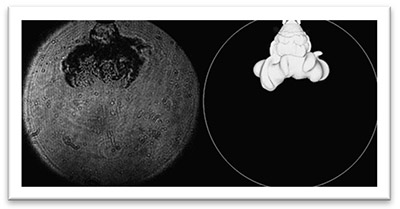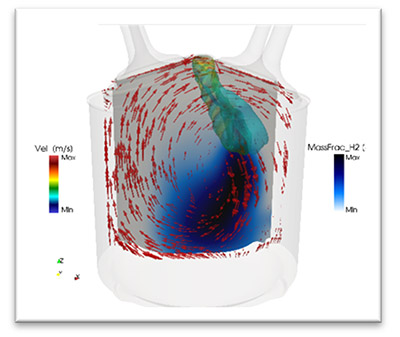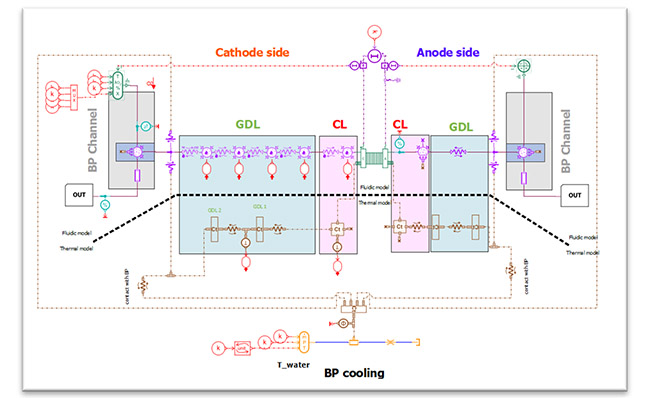The goal of carbon neutrality by 2050 requires a drastic reduction of transport-related CO2 emissions, which alone account for over 30% of global CO2 emissions. For road transport, decarbonization is expected to be partly based on the roll-out of battery-powered electric vehicles. However, the constraints imposed by this solution (battery weight and volume, range, charging time, recharging infrastructure) are such that not all uses can be addressed. This is the case for so-called heavy-duty applications (long-haul trucks, coaches, construction equipment), for which carbon-free hydrogen represents a credible alternative.
Two different approaches co-exist and are currently being studied at IFPEN:
- the internal combustion engine (ICE), using hydrogen directly as a fuel instead of the hydrocarbons currently available;
- fuel cells (FC), which use hydrogen to produce electricity on board and to power a vehicle's electric motor.
The hydrogen internal combustion engine (ICE)
The physico-chemical characteristics of hydrogen and their resulting properties make it a suitable candidate for combustion in an engine: wide flammability range, low ignition energy, high combustion speed.
In 2020, IFPEN began its work with an initial experimental campaign on a single-cylinder engine, which identified the obstacles to be overcome for this type of engine. To use hydrogen as a fuel, one of the main challenges is to ensure a high level of efficiency while controlling NOx emissions, while preventing abnormal combustion that could damage the engine [1] [2]. Figure 1 summarizes the challenges and the IFPEN1 research avenues for meeting them.

Today, IFPEN is committed to developing its resources and skills in order to meet all of the identified challenges [3].
In particular, 3D CFD tools serve to simulate the turbulent hydrogen combustion in an internal combustion engine, so that promising combustion chamber geometries can be optimised as early as possible in the design phase.
Fundamental research is therefore underway to ensure the robustness and predictability of these digital tools:
- visualization and simulation of H2 injection (figure 2) using advanced visualization tools developed by the “Mobility and Systems” Division;
- simulation using the Converge code of the H2/air mixture in the combustion chamber during direct H2 injection (figure 3);
- description of flame propagation and auto-ignition, representation of parietal phenomena2.


Fuel cells (FC)
The fuel cell vehicle is an alternative solution to the all-electric vehicle when the use of a battery alone no longer meets the user's demands: energy requirements exceeding 0.5 MWh profile over a given mission, or intensive use incompatible with a recharging time of several dozen minutes [4, 6].
The use of one or more FCs on board a vehicle requires a "system" approach in order to manage the many interactions between the various functions, both during vehicle design and during use: combined electricity generation (FC and battery), electrical adaptation between sources and on-board consumers, cooling of all vehicle components, consideration of the effects of FC ageing, etc.
The developments of the "Mobility and Systems" Division, carried out in close collaboration with other IFPEN divisions3, focus on three aspects:
- optimising the sizing of the battery/FC pair in order to consider not only energy requirements, but also power demands during the vehicle's assigned mission [5];
- the design of power electronics adapted to the simultaneous management of several sources of direct current (DC), with varying voltage at any given moment;
- minimizing the ageing of the battery/FC pair, through better identification and consideration of the phenomena that accelerate ageing, and optimising their coupled operation.
With regard to the latter, detailed modelling of the electrochemical and thermal phenomena at the heart of the fuel cells is currently underway (figure 4). The formation of liquid water at the heart of the cell - following the hydrogen reaction - then its transport and finally its evacuation are the subject of a specific study.

This detailed analysis of the specific features of these two propulsion modes using hydrogen as an energy vector is intended to provide complementary solutions as quickly as possible, adapted to the various usage cases of carbon-free mobility.
1- Each challenge can be addressed by several research axes and vice versa
2- Wall-related phenomena: heat transfer, formation of hot spots, etc.
3- "Digital sciences and technologies", "Physical chemistry and applied mechanics", "Economics and business intelligence"
Bibliographic references
- Rouleau L., Duffour F., Walter B., Kumar R. et al., Experimental and Numerical Investigation on Hydrogen Internal Combustion Engine, SAE Technical Paper 2021-24-0060, 2021.
>> https://doi.org/10.4271/2021-24-0060
- Laget O., Rouleau L., Cordier M, Duffour F., Maio G., Giuffrida V., Kumar R., Nowak L., A comprehensive study for the identification of the requirements for an optimal H2 combustion engine, International Journal of Engine Research.
>> https://doi.org/10.1177/14680874231167618
- Maio, G., Boberic, A., Giarracca, L., Aubagnac-Karkar, D., Colin, O., Duffour, F., Deppenkemper K., Virnich L., Pischinger, S. (2022). Experimental and numerical investigation of a direct injection spark ignition hydrogen engine for heavy-duty applications. International Journal of Hydrogen Energy, 47(67), 29069-29084.
>> https://doi.org/10.1016/j.ijhydene.2022.06.184
- Sery J., Leduc P., Fuel cell behavior and energy balance on board a Hyundai Nexo. International Journal of Engine Research. December 2021.
>> https://doi.org/10.1177/14680874211059046
- Loszka M., Martin R., Guyon O., Leduc P., TranpLHyn – Transports Lourds fonctionnant à l’Hydrogène. ADEME online bookshop, August 2022.
>> https://librairie.ademe.fr/mobilite-et-transport/5722--tranplhyn-transports-lourds-fonctionnant-a-l-hydrogene.html
- Leduc P., Véhicules à pile à combustible à hydrogène - applications et défis. Les 13èmes Tables Rondes de l’Arbois et de la Méditerranée, L’hydrogène : mythes et réalités, Aix-en-Provence, mai 2023.
Video on YouTube – Speech by Pierre Leduc (from 00:36:00 to 01:15:00) :
>> https://www.youtube.com/watch?v=KJBNfNuGQHM
Scientific contacts - Hydrogen combustion: florence.duffour@ifpen.fr - Fuel cells: pierre.leduc@ifpen.fr





